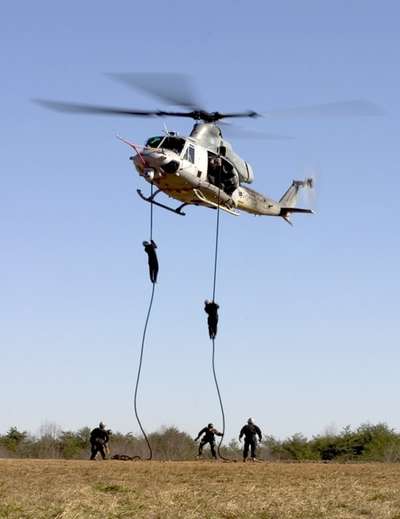Upgrade program achieves milestone, heads for final operational
evaluation
The rockets’ red glare recently gave proof that not only
is the H-1 Upgrade Program still here but has achieved 2,000 flight
hours amid weapons accuracy testing and operational assessment by
the Fleet.
H-1 Upgrades flight test directors aren’t sure if the
milestone hour mark came May 6 during AH-1Z rocket accuracy testing
conducted at the Army’s Yuma Proving Ground in Arizona by
Marine Corps Maj. Jon Selby and Bell Helicopter test pilot Herb
Moran, or during UH-1Y external loads testing conducted here the
same day by Marine Corps Maj. Pat Lindauer and Bell Helicopter test
pilot Troy Caudill.
This confusion pleases Col. Doug Isleib, program manager for the
H-1 program here. “It’s always been about the people
behind the technology,” Isleib explained, “not the
technology itself. From the engineers and assembly artisans to the
flight test engineers and pilots, they’ve poured a lot of
sweat equity into this program by solving problems, overcoming
challenges and flying long hours to send these aircraft out to the
people who matter most of all – the Marines in the Fleet
Marine Force.
“We have a lot of different pieces coming together in
fielding two nearly identical platforms,” Isleib continued,
“And seeing a milestone like this come while we’re
testing five aircraft in Arizona, Virginia and Maryland is a real
indication of the professionalism and diligence that not only got
us here but will see us through to production.”
With two aircraft engaged in the program’s second
operational assessment, the program is anticipating positive
feedback from Fleet operators in preparation for the final
operational evaluation and the Milestone C decision to proceed with
full rate production, currently scheduled for November, 2006.
Weapons testing in
Arizona, meanwhile, is proving the AH-1Z’s ability to perform
its primary mission – close air support. One month into a
four-month test, the aircraft has already fired Mk66 2.75-inch
rockets and its Mk197 20 mm gun using the Thales “Top
Owl” Helmet-Mounted Sight and Display System. Yet to come are
Hellfire anti-armor missile and AIM-9 Sidewinder air-to-air missile
shots.
UH-1Y testing here is working towards starting weapons firing
and accuracy testing within the month and taking place here and at
the Army’s Fort A.P. Hill in Virginia. The milestone flight
occurred during testing of the UH-1Y’s handling qualities
with a 3,650-lb external load.
All testing of the aircraft so far has provided valuable input
to the flight test team here and will yield a vastly improved
capability to the Marine Corps, according to Bell
Helicopter’s flight test director, Young Davidovich.
Currently, the Marine Corps flies 30-year old UH-1N Hueys. And
although the AH-1W Super Cobras successfully taking the fight to
insurgents in Fallujah, Iraq, and elsewhere are newer, they too
offer opportunities for technology improvement that will reap
benefits in the form of survivability, lethality and
maintainability.
“This flight hour milestone comes only three years after
first flight and demonstrates the maturity of the program,”
Davidovich said. “The aircraft are performing well and
we’re tracking towards successful completion of the test
program.”
Program officials agreed. “Getting to 2,000 hours is a
direct result of the diligence exercised by the test team in its
safe and deliberate execution of a solid test plan,” said
Marine Corps Lt. Col. David Anderson, H-1 Assistant Program Manager
for Systems Engineering. “Achieving 2,000 flight test hours
in approximately three years shows us the inherent robustness of
the platform and the program-wide professionalism behind
it.”

After remanufacture, the H-1 Upgrades aircraft will feature the
latest technology in rotor and drive train design, avionics,
sensors and weapons. They also share approximately 84 percent of
their parts, making them far more maintainable, supportable,
survivable and deployable than today’s H-1 aircraft.
“The Fleet’s going to love these aircraft,”
Davidovich said. By 2014, the Marine Corps will have procured 100
UH-1Y Hueys and 180 AH-1Z Super Cobras.
FMI: www.navair.navy.mil
 ANN's Daily Aero-Term (04.25.24): Airport Rotating Beacon
ANN's Daily Aero-Term (04.25.24): Airport Rotating Beacon ANN's Daily Aero-Linx (04.25.24)
ANN's Daily Aero-Linx (04.25.24) Klyde Morris (04.22.24)
Klyde Morris (04.22.24) Airborne 04.24.24: INTEGRAL E, Elixir USA, M700 RVSM
Airborne 04.24.24: INTEGRAL E, Elixir USA, M700 RVSM Airborne 04.22.24: Rotor X Worsens, Airport Fees 4 FNB?, USMC Drone Pilot
Airborne 04.22.24: Rotor X Worsens, Airport Fees 4 FNB?, USMC Drone Pilot



